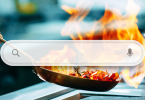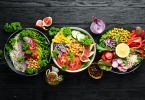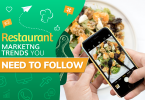Restaurant owners have a huge opportunity to grow their business across a variety of digital marketing channels — and that’s why they probably use one or two of them, maybe even a lot of them if they’re excited about the returns they’re already seeing.
But are they using those digital channels in concert with one another? Let alone all of them together?
Using Twitter, or starting a blog, or setting up your Pinterest boards — these are all great starts to strong digital marketing. But the magic happens when those channels work together.
This post will walk through a scenario (we’ll pretend you’re hosting a special 4th of July event at your restaurant) that demonstrates how to build a marketing plan do just that … run digital marketing campaigns across multiple channels that all work together. Use these steps as a template for any campaign you launch going forward.
Step 1. Publish a blog post announcing your event.
Alright, so you’re having a 4th of July event at your restaurant and you want to see a line out the door. The first thing to do is write a blog post about the event — which you should consider the canonical piece of content on that event.
It’s important to have all the information on the event in one place so it’s easy to find and easy to link to — both for your own multi-channel campaigns, and for any PR you receive about the event from third-party sources.
The core information the post should include is:
- When and where the event is taking place — remember to include both day and time
- Why it will be awesome — in other words, your value proposition
- A call-to-action — whether it’s to register (if that’s required), or to add the event to their calendar
Step 2. Include social sharing and follow buttons on that blog post.
Now that you have a blog post ready to go, be sure it’s easy to make that blog post socially shareable for anyone that reads it — that way, you widen the reach of your post, thus widen the reach of your event.
Include social sharing buttons on that post (buttons that let people share the event on Twitter, Facebook, Google+, Pinterest, etc.) as well as social follow buttons that let people follow your restaurant on social networks.
Including those two sets of buttons is the first step to running an integrated, multi-channel campaign, because it helps you bring a campaign from just one channel (your blog) to another channel (social media).
Step 3. Create and schedule social promotions.
Alright, now that you have a socially shareable blog post up about your 4th of July event, it’s time to actively promote your event on social media. You should start by sharing that blog post on social media, but it’s important you don’t stop there.
You should also take this time to create unique content about your event, and schedule it out over the coming weeks to keep promotion flowing.
Be sure to vary the content by channel — more visual content for Facebook and Pinterest, shorter punchier stuff for Twitter — and increase the density of promotion as the date gets closer. Don’t forget to use that blog post you wrote as the hub for all the event info by including a link to it in every single social promotion that goes out.
Pro Tip: You can use a higher frequency on some social channels (like Twitter) than others (like Facebook). Don’t be afraid to tweet multiple times about your event on Twitter in a single day… but be sure to space it out a tad more on other channels that aren’t as saturated.
Step 4. Set up automated emails for your opt-in email list.
Now that you have a veritable promotion machine running on social, it’s time to make use of the email database you’ve grown. Those who have raised their hand and said, “Hi, I’m [Name] and I love your restaurant, please email me” are a gold mine for any campaign promotion.
If you have an email schedule already set up — for, say, a newsletter — include promotions for this event in there. But you may also want to set up a separate automated email send just for this particular campaign — especially if your newsletter only goes out once a month or biweekly, and that 4th of July date is looming over your head.
Just like your blog, you should be sure to add social sharing and follow buttons in your email, too.
Pro Tip: If you have an opt-in SMS list, you can set up messages for these folks, too. Just make sure the messages are timely, since this channel thrives on communications that recipients can take advantage of immediately.
Step 5. Update your homepage with an event CTA.
Your website’s homepage is one of the best pieces of real estate you have. Think about it. Your dedicated customers probably keep in touch with you via your email list, storefront, blog, or social media accounts. But new customers — the ones that don’t know who you are yet — are checking your homepage out right now to learn more about your establishment.
Use this opportunity to capture the return customers and the new customers with a prominent homepage callout to help promote your event, and tie your campaign together. The callout should link to that blog post you wrote so those who see it can find more information about the event.
Step 6. Put paid muscle behind it.
This step is optional, but if you really want to give some serious promotion to your multi-channel campaign, paid digital ads are always an option. The most common option is Google AdWords, but I’d encourage restaurant marketers to look at social PPC as an option.
Networks like Twitter and Facebook let marketers promote events right there on the social network, and Facebook in particular has noteworthy demographic targeting options that’ll let you narrow in on the perfect audience for whatever it is you’re trying to promote.
Image credit: rosmary







